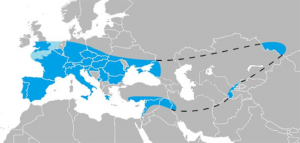What happened?
- Neanderthals (Homo neanderthalensis), the closest relatives of modern humans (Homo sapiens), lived throughout Europe and parts of Asia from about 400,000 BCE to about 40,000 BCE.
- Neanderthals and modern humans last shared a common ancestor in Africa around 800,000 BCE. Ancestral Neanderthals migrated out of Africa into Europe and Asia around 500,000 BCE, after which the two species evolved separately.
- Neanderthals hunted large prey, such as mammoths and wooly rhinoceros.
- At the time of their disappearance around 40,000 BCE, Neanderthals were facing pressures from several factors.
- They had a low population density with dwindling genetic diversity.
- Modern humans may have been competing with them.
- Modern humans migrated out of Africa around 50,000 BCE and came into contact with Neanderthals.
- Modern humans grew more slowly and had longer life spans than Neanderthals, allowing them to sustain larger populations.
- Because of the pressures Neanderthals were facing, they disappeared around 40,000 BCE. Neanderthals were replaced by or assimilated into modern human populations that they had come into contact with.
- The genome of Eurasian people today is made up of about 2% Neanderthal DNA.
- Neanderthals are also commonly referred to as Homo sapiens neanderthalensis, or a subspecies of modern humans.

Map of Neanderthal range in Europe and eastern Asia. Blue areas mark where evidence of Neanderthals has been found. The black dashed line completes the proposed range (from Hendry, n.d.).
How is this related to climate?
- Not long after Neanderthals came into contact with modern humans, two very cold, dry periods hit Europe.
- The first began around 42,000 BCE and lasted for a thousand years. The second began around 38,800 BCE and lasted for about 600 years.
- The cold climate itself did not cause the Neanderthals to disappear. They had short, stocky bodies that made them well-adapted to cold climates and had survived several cooling events before.
- The cold periods transformed central Europe from woodland to an Arctic-like steppe. Because of this, the large animals that Neanderthals relied on for food and supplies migrated south.
- Neanderthals could not adapt to a change in their diet without large prey, putting an additional pressure on an already-shrinking population. While this was not the sole cause of their eventual disappearance, it likely contributed to it.
- Evidence suggests that modern humans were able to adapt to rely on different food sources, such as a variety of plants, fish and meat, allowing them to survive the periods of cold climate.
- References and additional resources
- Daley, J. “Climate Change Likely Iced Neanderthals Out Of Existence.” Smithsonian. 2018. https://www.smithsonianmag.com/smart-news/modern-humans-didnt-kill-neanderthals-weather-did-180970167/.
- Harvati, K. “What Happened to the Neanderthals?” Nature. 2012. https://www.nature.com/scitable/knowledge/library/what-happened-to-the-neanderthals-68245020/
- Hendry, L. “Who were the Neanderthals?” National History Museum of London. n.d. https://www.nhm.ac.uk/discover/who-were-the-neanderthals.html.
- History.com Editors. “Neanderthals.” History. 2017. www.history.com/topics/pre-history/neanderthals.
- Lieberman, B. and Gordon, E. Climate change in human history: prehistory to the present. London, Bloomsbury Academic, 2018.
- Williams, F. L., et al. “Neanderthal.” Encyclopedia Britannica. 2020. https://www.britannica.com/topic/Neanderthal.
